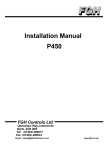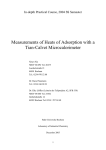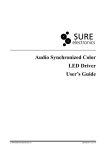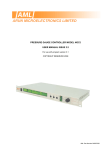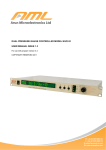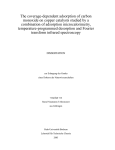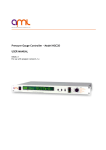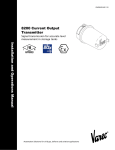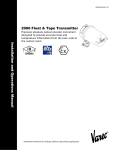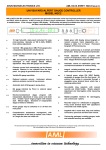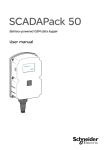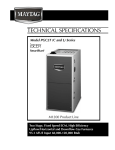Download PGC3 - Arun Microelectronics Limited
Transcript
ARUN MICROELECTRONICS LTD. PRESSURE GAUGE CONTROLLER MODELS PGC3 and PGC3T. USER MANUAL ISSUE 1.3 AML Part Number SPGC3MANUSR For use with Program Version 1.06 onward. COPYRIGHT RESERVED 1991, 1994 The information contained in this manual has been carefully checked and is believed to be correct. No responsibility is assumed for any errors. User comment and criticism is welcome: please write quoting the serial number of the instrument and the version number of the software as displayed by the instrument to: Customer Services, Arun Microelectronics Ltd., Fitzalan Road, ARUNDEL, West Sussex. BN18 9JP England. Please direct other enquiries to the distributor or agent from whom you purchased the instrument. CONTENTS 1. INTRODUCTION 2. INSTALLATION 2:1 Checks on receipt of the instrument. 2:2 Ion gaugehead installation. 2:3 Instrument installation. 2:3.1 Mounting. 2:3.2 Ventilation. 2:3.3 Connection to the mains supply and earthing. 2:4 Fusing. 2:5 Ion Gauge Cables. 2:5.1 The ion gauge power cable. 2:5.2 The ion gauge collector cable. 3. OPERATION 3:1 Familiarisation 3:1.1 Switching On, basic display functions 3:1.2 Password protection 3:1.3 Preparing to measure pressure. Setting the Ion Gauge parameters. 3:2 Pressure Measurement. 3:2.1 Pressure measurement using Pirani/TC Gauges. 3:2.2 Calibration of Thermocouple Gauges. 3:2.3 Starting the Ion Gauge. 3:2.4 Problems with starting or running the Ion Gauge. 3:2.5 Measuring pressure with the ion gauge. 3:3 Emission current selection. 3:4 Operation of the ion gauge at high pressures 3:5 Process Control and Trips 3:5.1 Use and wiring of the relays 3:5.2 Assigning the relays to gauges 3:5.3 Setting trip pressures 3:6 Leak Detection. 3:7 Resistive Degas. 3:7.1 Running degas. 3:7.2 Problems in degas. 3:8 Capacitance Manometer 3:9 Recorder Output. 2 CONTENTS 3:10 External inhibit of the Ion Gauge. 3:11 Remote operation 4. FAULT MESSAGES APPENDIX A Gauge principles. A.1 Ionisation gauges. A.2 Pirani/TC Gauges A.3 Capacitance Manometers. APPENDIX B Connectors. B.1 Mains connector. B.2 Ion gauge power connector. B.3 Ion gauge collector connector. B.4 Pirani connectors. B.5 Remote connector. B.6 Auxiliary connector. B.7 Thermocouple gauge connectors. APPENDIX C Host Computer Serial Interface. RS232 output data format. APPENDIX D Functions and locations of the internal links. 3 1. INTRODUCTION This Pressure Gauge Controller is designed to replace earlier generation equipment and provides enhanced performance and facilities at significantly reduced size and with no increase in cost. The large easily-read LED display allows viewing of pressure in either bargraph or numeric formats, selectable with a single key. A voltage analog of ion gauge pressure is available. Four mains-power-rated changeover relays, flexibly assignable to gauges by means of internal links, are provided. Pressure setpoints for the relays are maintained in the absence of mains power. Ease of Use The instrument is controlled by a single rotary switch, the functions of which are clearly marked. The indication of pressure and trip pressure settings are controlled by three keyswitches. High Accuracy The two most significant factors which determine the performance of ion gauge controllers are the accuracy of emission control and the quality of the electrometer measuring the collector current. This unit offers improvements in both of these critical areas. Precise Emission Control The filament power is provided by a smooth, direct current supply controlled by a fast-acting control circuit instead of the normal transformed and chopped mains supply. This allows control of emission current to an accuracy of about 1%, besides eliminating a source of potential electromagnetic interference. Advanced Electrometer Design An electrometer with a logarithmic characteristic is included as this gives a wide dynamic range which is guaranteed to be monotonic and smooth over the entire range of the ion gauge. A novel compensation technique ensures that the error currents in the logging circuits do not cause an optimistically low pressure reading to be given at the bottom of the operating range, as is common in log electrometers. The settling time at low input currents is minimised by a new non-linear frequency compensation technique. Conformance and high ambient temperature performance are improved by advanced temperature compensation techniques. The electrometer is mounted directly in the path of incoming forced air and is thermally isolated from internal sources of heat. 4 2. INSTALLATION 2:1 Checks on receipt of the instrument. On receipt of the instrument remove all packing material and check that all items on the shipping list have been received. Report any damage or shortages to the Company or the Agent who supplied the instrument. The packing material has been specially designed to protect the instrument and should be retained for possible future use. 2:2 Ion gaugehead installation. Consult the information supplied with the gaugehead for advice on flanges, gaskets and adaptors for mechanical fixing. Consult section 2:5 and Appendix B for more information on making or adapting cables to connect between the gaugehead and instrument. Mount the gaugehead in a position where the free electrons generated in its vicinity will not affect other equipment. The performance of the ion gauge may be affected by other electron or ion generating processes within the vacuum chamber: should shielding of the gaugehead be necessary, ensure that the conductance between the gaugehead and volume of interest is not significantly decreased by its presence. The orientation of the gaugehead should be such that the filament is to the side of, or below, the grid structure. This will ensure that if the filament should sag or break it will not short-circuit to the grid. The gauge and controller are protected from all normal failure modes. Users should be aware of potential hazards from other equipment, however, particularly those introducing high voltages into the vacuum chamber (X-ray sources for example). As a direct discharge from one of these at high pressure may cause extensive damage, shielding should always be introduced in such cases. 2:3 Instrument installation. 2:3.1 Mounting. The instrument is suitable for mounting in a standard 19" rack and occupies 1U (1.75" , 44.5mm) of the rack. The mounting holes in the front panel are intended for retaining the instrument in the rack and will not support its weight. Additional support is required toward the rear and various arrangements are provided by rack manufacturers for this purpose. Support brackets may be mounted on the tapped M3 fixing holes on the sides near the rear. If these or other arrangements are attached to these holes, ensure that the screws used are steel and penetrate the case between 6 and 10 millimetres. 2:3.2 Ventilation. The instrument is forced-air ventilated through grilles on the right side and a vent in the rear panel. Mount it in a location where there is an adequate supply of air as close as possible to cool room-ambient temperature. The instrument is tolerant of, and is compensated for, operation at elevated ambient temperatures up to 45 Celsius. Long-term accuracy and reliability will be enhanced by operation at the lowest possible temperature. If there are other instruments in the rack which generate significant amounts of waste heat, try to ensure that this is deflected away from this instrument. 5 2:3.3 Connection to the mains supply and earthing. The mains is connected via an IEC CE22 pattern connector. THE INSTRUMENT MUST ALSO BE CONNECTED TO EARTH BY THE STUD PROVIDED. FAILURE TO PROVIDE THIS CONNECTION MAY RESULT IN A SHOCK HAZARD FOR THE OPERATOR IF HIGH VOLTAGES ARE CONNECTED TO THE GAUGE OR SIGNAL LEADS WHEN THE MAINS LEAD IS DISCONNECTED. The mains supply is filtered to help prevent conducted electromagnetic interference affecting the operation of this or other equipment nearby. To ensure that this filtering is effective, and because there is an earth leakage current generated within the instrument, it is necessary to return this directly to the vacuum system ground reference star point. Ensure that other instruments are directly and separately earthed so that return or fault currents cannot flow in any common ground impedance. This is particularly important in cases where there are high voltage power supplies in the system. In such cases there must be specific low impedance paths for return or flashover currents: reliance on frame continuity or sneak paths will cause noises and spikes to be coupled into instrumentation. Low resistance connections do not necessarily have low impedance, which is most successfully achieved with a Litz conductor of large cross-section and number of strands. Information on wiring for process control will be found in section 3:5, below. 2:4 Fusing. Two fuses for instrument protection are provided. Do not use fuses of other types or ratings, as this may result in damage to the instrument or gaugeheads under fault conditions. The rating of the mains fuse is dependent on the range of supply voltages from which the instrument is to be operated, and is printed on the rear panel adjacent to the fuseholder. It must be replaced with a 20mm x 5mm glass anti-surge fuse of the type and rating. Such fuses are marked with a "T" after the current rating: ceramic types are not suitable. Spare fuses are provided in the accessory kit. There is provision to house a spare fuse in the fuse drawer, which is integral to the mains connector. It is necessary to disconnect the mains supply when replacing fuses. 6 2:5 Ion Gauge Cables. The use of correctly constructed cables will enable the instrument to meet its specification. The following is a general guide to the considerations affecting ion gauge cable construction: a specification of connector types and pin connections is given in Appendix B. 2:5.1 The ion gauge power cable. Caburn-MDC supply cables type CLIG1 for use with this controller and MDC type BATT and BAIR gaugeheads. The use of this cable is recommended. The ion gauge power cable must be made with conductors of cross section adequate to carry the normal filament and degas currents or the worst-case fault currents at the highest ambient temperature expected. The cross sectional area of all the wiring should be a minimum 1 square millimetre and preferably more. The insulation on all wiring should be rated for at least 500 volts RMS and should be adequately protected against mechanical damage. For the filament current (pins 4, 5 and 6) the wiring should be rated at 6A or more. The degas grid current can be 17 A and the wiring on pins 10 and 12 must be capable of carrying this current: types BK 32/0.2 and BK 30/0.25 are suitable. A further consideration is the voltage drop in the cable at maximum current. It is good practice to minimise the drop in the cables by making them as short and of as large a cross section as is convenient, as this minimises the temperature rise in the instrument. Long cables of inadequate crosssection may cause the instrument to be unable to support emission or supply adequate degas power, and error messages reporting spurious gauge failures may result. AML will be pleased to advise on the subject of long cables. 2:5.2 The ion gauge collector cable. The ion gauge collector cable should also be as short as convenient. The centre pin of the BNC connector must be gold plated. Although this cable is screened, the amount of interference which can be induced is proportional to its length and can become significant at extreme UHV. Site the cable run away from other cables carrying high power or high frequency signals. The cable installation should be such that movement or flexing is discouraged. Mechanical movement of the cable can generate triboelectric charges which may affect UHV measurements. It is important to avoid the production of "earth loops" in sensitive signal return paths as these can have significant currents induced in them at mains frequency. The screen of the collector cable should ONLY be earthed at the instrument end. If existing cables are to be adapted, and are currently connected to earth at the gauge end, disconnect the screen but ensure that the guard cylinder around the collector feedthrough on the ceramic gauge base remains connected to the chamber earth. This is important, as it provides a path to earth for leakage on the surfaces of the ceramic from the grid voltage which would otherwise add to the collector current. 7 3. OPERATION 3:1 Familiarisation Operation of the instrument is designed to be easy for users familiar with vacuum system operation and with the types of gauges used. Brief descriptions of the principles of operation of various types of gauge will be found in appendix A. 3:1.1 Switching on, basic display functions. Connect the instrument to the mains supply. Do not connect any gauges or other equipment to the connectors on the rear panel at this stage. Rotate the emission switch to the "OFF" position. Switch on. The green LED indicator adjacent to the mains switch will illuminate and the fan will start and the main LED display will show sequentially "PGC3" then "V X.YY" (X.YY is the version number of the embedded software.) then "P1 ATM" with a pair of dots on the left end indicating the units of pressure measurement. Further dots at the right end of this display may be illuminated, showing that one or more of the relays is energised. The "Pirani/TC" LED display will show two horizontal bars. 3:1.2 Password protection Access to the process control trip settings is controlled by a 3 digit password number. DECIDE WHAT YOUR NUMBER IS TO BE AND RECORD IT! To set the password press the TRIPS switch. The main display will show "PW ???". Using the INC and DEC switches set the number you have decided and press TRIPS again. Press TRIPS a further four times to cycle through the trip displays: these are described fully in section 3:5, below, but understanding them is not required at this stage. 3:1.3 Preparing to measure pressure. Setting the Ion Gauge parameters. Disconnect the power connector and remove the smaller screws at the sides of the instrument. Note that the ventilation slots are at the right side, when viewed from the front. Remove the cover in an upward direction and locate LK2 at the rear of the right hand circuit board, near the filament switch. Spare links are stored on LKPARK which is on the left edge of the same circuit board. Fit or remove links on LK2 according to the following: Specifying the Pirani/TC Interlock. Locate LK3, adjacent to the LKPARK. Fit a link in the "PLOCK" position to prevent starting the ion gauge when Pirani/TC 1 pressure is above 1.0E-2 millibar. 8 Specifying the units of pressure measurement. Fit links to LK3 according to the following; Pascal Millibar Torr fit no link to U0 or U1 fit link U0 only fit link U1 only Before replacing the cover you may wish to adjust the links which specify other functions: a tabular review of all links on LK3 and a diagram of their location is shown in Appendix D. Ensure that there are no loose links or foreign material inside the instrument. Replace the cover with the ventilation slots at the right hand side and replace the screws. Do not use screws longer than those supplied. Adjusting the ion gauge filament current limit and sensitivity. If the gaugehead manufacturer has a recommended limit adjust to a little below that limit. In the absence of a recommendation select about 1.5 Amps for Iridium and 3.0 Amps for Tungsten. This will probably be too low for most gauges under all conditions but will protect the filaments. Switch on with the emission switch in the "OFF" position and wait for the signing on messages to finish. Press a "Change Display" switch until "LIM Y.Z" is displayed. Y.Z is the current limit in amperes. Use an instrument screwdriver with a 3mm blade, and insert this in the hole on the front panel marked "LIM". Using no more pressure than is necessary to keep the screwdriver in the slot, turn the single-turn adjustment until the desired limit is displayed. Press a "Change Display" switch until "S = ZZZ" is displayed. ZZZ is the ion gauge sensitivity expressed as the reciprocal of the specified units of pressure measurement, for example per millibar. Adjust to the value appropriate to the gauge with a screwdriver inserted through the hole marked "SENS". The correct setting for MDC Vacuum Products Corporation's gaugeheads type BAIR and BATT is 10/Torr (= 7.5/mBar = 0.075/Pa). 3:2 Pressure Measurement. 3:2.1 Pressure measurement using Pirani/TC Gauges. The instrument is supplied for operation of EITHER AML Pirani gauges type PVU and PVB OR MDC Thermocouple gauges types TGT2A and TGT2AM, as defined by the absence or presence of suffix T in the model number marked on the rear panel, respectively. Use of the incorrect gauge type or gaugeheads of other manufacture may result in damage to the instrument or gaugehead. AML Pirani gauges have internal adjustments and are supplied pre-calibrated, in distinction to thermocouple gauges which require the controller to provide this facility. Calibration of thermocouple gauges before use is essential and is described in section 3:2.2. Switch off, disconnect the mains power lead and connect the gauges. Ensure that the lead of the Pirani/TC gauge which is interlocked to the ion gauge is connected to the Pirani/TC 1 connector on the rear panel. Reconnect the power lead, and switch on. Pirani/TC gauges and capacitance manometer are powered up immediately. The left section of the LED display shows a low-resolution histogram of Pirani/TC pressure at all times. This should be read against the scale at the top or bottom as indicated by the line to the illuminated pressure unit indicator LEDs at the left end of the main section of the LED display. 9 Pressing the "CHANGE DISPLAY" switches will change the format of the display and the source of the measurement sequentially. P1 and P2 are Pirani gauges, T1 and T2 are thermocouple gauges and C is the capacitance manometer. The numeric indications of Pirani/TC pressure allow a higher resolution measurement of these pressures to be made. If "P1 OC" or "P2 OC" is displayed the sensing filament is open circuit. Pirani/TC gauges are not very accurate or repeatable transducers at pressures close to atmospheric. For this reason, the instrument has no discrimination of pressures between 1 bar and 5 mbar. This is of no practical consequence, since a typical rotary-pump roughed system will traverse this range in a few seconds and will adequately indicate that pumpdown is progressing by making the characteristic noises. Badly-calibrated or oil-contaminated Pirani/TC gaugeheads may even indicate 5 mbar or less at atmospheric pressure! Accurate pressure readings in this range are achieved by capacitance manometers. 3:2.2 Calibration of Thermocouple Gauges. PGC2T includes a multi-turn potentiometer adjacent to each thermocouple gauge connector on the rear panel. This is used to adjust the TC heater current and for safety this is adjusted to minimum (fully counter-clockwise) before despatch. Calibration before use is essential. Connect the gauge to the PGC and expose it to atmospheric pressure and ensure that the instrument indicates "ATM" without adjustment. Pump the gauge to a pressure below 10-3 millibar or torr. Adjust the potentiometer until a reading of 1E-3 is obtained. Do not adjust the potentiometer any further in the clockwise direction as this may damage the gaugehead. 3:2.3 Starting the Ion Gauge. Before starting the ion gauge you should have specified the filament type, and set the filament current limit as described in section 3:1.3, above. Select the filament in use by means of the toggle switch on the rear panel. Gauges type BAIR have only a single filament and if these are used with a CLIG1 lead which has been correctly installed will operate if "Filament 1" is selected. Start pumping the system. When the system pressure is low enough, attempt to start ion gauge emission. The Pirani/TC interlock will prevent this if Pirani/TC 1 pressure indication is above 1x10E-2 millibar. Emission should be initiated at 100μA. Rotate the switch to the 100μA position and observe the LED display. While the gauge filament is heating the display shows the selected emission current. After about five seconds a display of pressure in numerical format should be shown. There may be a pressure burst after the gauge is started, due to evolution of gas from the hot filament. However, if the system pressure is very low and if the gauge has been previously outgassed the initial display may indicate a very low pressure which may take some tens of seconds to settle to a representative reading. If any display other than a reasonable display of pressure is obtained after about 30 seconds refer to section 3:2.4 for an explanation. When the pressure display stabilises switch emission off and select the other filament (if there is one). Operate the second filament at 100μA for a minute or two. This will equalise the stress in the filaments. Increase the emission current to 1mA and then to 10mA after the pressure reading is stable again. It will be necessary to increase the "LIM" adjustment to achieve emission at higher currents if "IG UEM" is displayed. 10 When you have achieved 10mA emission you should then turn the "LIM" adjustment slowly anti-clockwise just until underemission is reported. View and record the current limit and then increase it slightly to give a margin of safety. If the ion gauge or filament is changed the adjustment will need to be repeated. It is worthwhile taking the trouble to find the optimum setting of this control, as this will improve the protection and longevity of the filament. 3:2.4 Problems with starting or running the Ion Gauge. If "IG UEM" (underemission) is reported at startup or on increasing emission this is probably due to the filament current limit being set too low. However, if the grid is not connected or shorted to ground the same message will be given. Prudent operators will check the cables before increasing the allowed filament current. Disconnect the mains power connector before checking any cables. The filament current limit adjustment can be made at any time but it is advisable only to do so when the ion gauge is off and the limit is being displayed. If "IG OEM" (overemission) is shown there is probably a short circuit from grid to filament. Disconnect the mains power connector before checking cables. If "FIL OC" (IG filament open circuit) is shown the cable or filament is probably open circuit. The same message is shown if the gauge connector is not properly mated, or a non-existent filament is selected. Disconnect the mains power connector before checking any cables. In some cases if there is a high resistance connection, or the cable is long, or of inadequate cross section this fault may be reported after some period of normal operation. Refer to section 2:5.1 regarding cables. To change to the other filament use the switch on the rear panel. Run the new filament at low emission to degas it. If "PLOCK" or "TLOCK" is reported the Pirani/TC interlock is preventing emission since Pirani/TC 1 pressure indication is above 1x10E-2 millibar. Pirani/TC gauges are generally more repeatable at the lower end of their pressure range, although not necessarily more accurate. AML Pirani gauges are shipped calibrated but there is an adjustment for the low pressure end of the scale, and this may need attention. Alternatively, if you are confident that the system pressure is low enough and the Pirani/TC interlock is preventing the ion gauge from being run, then remove the interlock link, as described in section 3:1.3. If "EXT" is reported then emission is being prevented by an external inhibit signal on the Auxiliary Connector. If the emission LED is extinguished and the main LED display subsequently shows "PGC3" followed by a software version number then the instrument has detected a short-circuit on the filament. 3:2.5 Measuring pressure with the ion gauge. It is assumed that you have followed the procedure in section 3:2.3 and are running the ion gauge at 100μA emission current. Review the formats of pressure display available by pressing the "DISP" switch during emission the Pirani/TC pressure is indicated in the separate dedicated section of the LED display. The status of the four relays is shown at the right end of the main LED display. Four pairs of dots represent the status of the four relays. When illuminated these represent the energised condition. While ion gauge pressure is displayed in numeric format an arrow showing the current trend in measured pressure is shown at the right of the display. Two styles of histogram (bargraph) display are available, the long histogram shows most of the range of ion gauge pressures and the short histogram shows a single decade. The pressure trend is indicated by 11 a pointer superimposed at the right end of the bar. The long histogram is interpreted against a row of dots adjacent to scale marks on the panel which indicate the exponent. The mantissa is interpolated between adjacent scale mark dots. Although the resolution is only four points per decade this display is useful during pumpdown. At pressures below 1E10 millibar the long histogram display is not available and is replaced by the numeric display. The diagram below represents a short histogram of pressure at 2E-9 millibar. Note that the scale marks at the bottom of the display represent a mantissa from 1 to 10, with the double marks on 1, 5 and 10. For Pascal the scale is at the top. Note the downward trend indication and that relays A and C are energised. When the pressure reaches the end of the scale the instrument automatically changes to the next scale. The entire display can be replaced by a display of the gauge assignment and trip pressures of the relays, by pressing the "Trip" switch. More information on this is contained in section 3:5.2, below. Pressing the "Trip" switch a further four times will restore the former display. 3:3 Emission current selection. You may select 100μA, 1mA or 10mA of emission current in the ion gauge, as the gauge is being operated. For the majority of measurements emission of 1mA will be used. Although most gauges are substantially linear and the instrument regulates emission current well, maintaining 1mA emission wherever possible will eliminate some error in the readings. This instrument contains an advanced electrometer circuit which is well compensated for environmental changes. It is located directly in the path of a cooling airflow just where this enters the instrument, and it is thermally isolated from sources of heat. Operation of the instrument in conditions of high humidity may affect extreme low pressure measurements if condensation is allowed to form within the case. The most common cause of this is introducing a cold instrument into warm conditions. If this situation exists it will normally be self-correcting after a few hours of operation in non-condensing conditions. 3:4 Operation of the ion gauge at high pressures For operation at the upper end of the ion gauge pressure range, an emission current of 100μA is available. This may be used as a means of extending the upper pressure limit of operation with tungsten filaments as the operating temperature is considerably reduced, and oxidation (and other) reactions are retarded. The reduction in temperature of Thoria-coated Iridium filaments is not so significant. In all cases the recommendations of the gauge manufacturer on this matter should be followed. 12 3:5 Process Control and Trips Four process control relays are provided, which can be used in variety of ways. The relays and their contacts are described in the following paragraph, and their assignment and use in the remainder of this section. 3:5.1 Use and wiring of the relays. The contacts of the relays are shown diagrammatically on the rear panel legend, in the de-energised condition, adjacent to the terminal blocks to which they are connected. Switching loads of more than 5 Amps is not recommended. Inductive loads, including contactor coils, should have "snubber" networks connected in parallel to avoid arc generation which could interfere with the operation of this and other equipment. In general, avoid introducing noise sources into the instrument via the relay contacts. The external wiring is connected to the instrument through a two-part pluggable terminal block. This can be removed and wired independently of the instrument. Ensure that external wiring is of adequate cross section for the load current. Strip and twist the wires (do not tin them) and poke into the receptacle in the terminal block. Close the leaf on the wire by tightening the screw immediately above. Take appropriate action to strain-relieve the wiring nearby and to restrict access to the terminals if harmful voltages are to be present. Fit the terminal block cover supplied in the accessory kit to retain the connector and prevent debris falling into the screw heads. 3:5.2 Assigning the relays to gauges. Each relay is assigned to a gauge and the relay is energised when the pressure is below the setpoint. The hysteresis is fixed and the relay will de-energise when the pressure exceeds twice the setpoint pressure. Adjustment of setpoints is described in section 3:5.3. Relay A is assigned to the ion gauge. Relay B is assigned to Pirani/TC 1. Relay C and D are assigned to the ion gauge, Capacitance Manometer or Pirani/TC 2 by means of internal links. Review their current assignments by pressing the "Trips" switch until the LEDs associated with these relays flash. While these LEDs flash the display shows assignments of the relays C and D. If these are not as desired they may be changed by the following procedure. Disconnect the power connector and remove the smaller screws at the sides of the instrument. Note that the ventilation slots are at the right side, when viewed from the front. Remove the cover in an upward direction and locate the LKPARK and LK3 at the left hand side of the right hand circuit board. Spare links are stored on LKPARK. Fit or remove links on LK3 according to the following: A link in the RLC position on LK3 assigns RLC to the ion gauge. No link in the RLC position on LK3 assigns RLC to the Capacitance Manometer. A link in the RLD position on LK3 assigns RLD to the ion gauge. No link in the RLD position on LK3 assigns RLD to Pirani/TC 2. A link on the "NIGREN" position on LK3 causes the relays assigned to the ion gauge to be energised when the ion gauge is not operating in normal emission. Before replacing the cover you may wish to adjust the links which specify other functions: a tabular review of all links on LK3 and a diagram of their location is shown in Appendix D. Ensure that there are no loose links or foreign material inside the instrument. Replace the cover and screws in the correct locations. Do not use screws longer than those supplied. 13 3:5.3 Setting trip pressures When the instrument is running the assignment of the trips and the trip pressures can be reviewed at any time except during degas or when a fault message is displayed. Pressing the "Trips" switch causes the main display to show "PW ???", unless you set the correct password number with the INC and DEC switches and confirm it with the TRIPS switch, you will not be allowed to modify the trip pressures. If a password has not previously been set you should do so now and RECORD THE SELECTED NUMBER. If a password was set and you have forgotten the number refer to Appendix D (LK4) for information on how to reset it. After the password is entered (or not if trips are to be reviewed without modification) the two LEDs adjacent to "RLA" to flash. The display shows "I X-YY" , and indicates that relay A is assigned to the ion gauge and that the trip pressure is XE-YY units. Pressing the "Trips switch more times reveals the assignment and trip levels for the other relays in turn. P1 and P2 are Pirani trips, T1 and T2 are thermocouple gauge trips and C is the Capacitance Manometer trip. If relay C is not displayed then it has been assigned to the capacitance manometer which has been specified as non-existent. While the display is in this condition the trip levels may be adjusted by means of the "INC" and "DEC" switches if the password was entered at the start of the sequence. Note that the terminal values reached are "EN" and "DN" , representing the permanently energised or de-energised condition of that relay. The new trip levels become active when all four have been reviewed and changed if desired and the normal display is restored. If a delay of more than about 15 seconds occurs during the review process in which no switches are pressed then the trip display "times out" and the normal display is restored with all the trips unchanged. The trip levels are maintained in the instrument's memory, even when the power is switched off. Users of trips on pirani and thermocouple gauges should be aware that the resolution and repeatability of such gauges is relatively poor and that trips set outside the range 5x10E-3 to 5mBar may exhibit undesirable repetitive switching. 3:6 Leak Detection. The leak detector works by indicating rapid changes of pressure on a bargraph and a frequency-modulated tone. Such changes are produced with a probe gas or volatile blocking agent. It is difficult to exercise this function unless you have a leak valve (or a leak!) on the system, although you may be able to produce a pressure burst by switching on other equipment or firing a titanium sublimation pump. During leak detection the ion gauge overpressure trip and process control relays function normally. Select which gauge is to be used by switching the ion gauge into emission to leak detect using the ion gauge or switching emission off to use Pirani/TC 1. Which gauge is best to use will depend on the pressure at which the leak is limiting pumpdown. If you select the ion gauge the interlock with Pirani/TC 1 still functions. 14 Press the "Change Display" switches until the LED display shows "LEAK" followed by a histogram of rate of pressure deviation with baseline restoration. If you have means to simulate a leak, you should do so and observe the effect on the display and tone. The sensitivity of the ion gauge leak detection can be altered by changing the emission current. A volume control for the sounder is adjacent to the emission control switch and is accessible with an instrument screwdriver with a 3mm blade. After a pressure change has been observed, turn off the probe gas supply or stop applying the blocking agent and wait until the baseline restorer has caused the histogram and tone to return close to the centre of their range. This shows that the leak detector has adjusted to the new system pressure and does not necessarily indicate that the pressure is the same as before probe gas was introduced via the leak. A blocking agent may give rise to a deviation first to the right and then to the left before settling. A probe gas may give a single deviation in either direction, depending on the relative sensitivity of the ion gauge to the residual gas in the chamber and the probe gas, and to the relative pumping rates for those gases. Further localisation of a leak may be attempted after the deviation has been restored. 3:7 Resistive Degas. Ion gauges designed for resistive degas have a helical filament made of resistive material. In order to degas the filament a current is passed through the filament to raise it to red heat. The PGC3 is designed to supply between 35 and 40 watts to a typical gauge for a period of 30 seconds. Extended or repetitive degassing of these gauges over a short period is not recommended by the manufacturers, as melting of the grid could occur. The PGC3 prevents this by allowing a maximum duty-cycle on degas of 25%. Degas is only allowed to start at pressures below 1 x 10-5 millibars and is terminated if the pressure exceeds 1 x 10-4 millibar. Degas is only allowed if the emission current is 10mA. 3:7.1 Running degas. Gauges should have been run for some time at 10mA emission before pressing the "DEGAS" pushbutton, to ensure that the filament has been adequately outgassed. Ensure that the pressure in the system is sufficiently low, and that the pumping capacity is adequate for the expected gas load. Observe the main instrument display as the pushbutton is operated, as any fault message will be shown briefly. During degas the pressure is shown on the LED display and the emission LED flashes. Degas may be terminated by pressing the pushbutton again. Some fault conditions which terminate degas allow emission to continue, for example "P BURST". In these cases the error message is transient and there is no lasting indication of a problem. It is recommended that operators observe the display during degas a few times after the ion gauge has been exposed to air. 3:7.2 Problems in degas. If "IG UEM" is reported during degas a grid to ground short circuit may have occurred. Attempt to run normal emission before investigating the gaugehead or leads. If "P HIGH" is reported, the pressure was greater than 1 x 10-5 millibar when degas was attempted. If "P BURST" is reported, the pressure exceeded 1 x 10-4 millibar at some time during the degas period, and degas was terminated. 15 If "IG OEM" (overemission) is reported, there was either a discharge caused by a high gas load, or a short-circuit between grid and filament, caused by sagging or melting of the grid. First attempt to find any short-circuit: if none is found, check that emission at 100μA, 1mA and10mA is satisfactory, after which degas may be attempted again. If "GRID SC" is reported there is a short circuit between the two ends of the grid, either in the gaugehead or the connector and lead assembly. Since the cold resistance of the grid is about 0.1 ohm, which is difficult to distinguish from a short circuit, the lead should be disconnected for investigation. This fault message is not related to a grid to ground short circuit. If "WAIT" is reported then sufficient time has not been allowed since a previous degas was attempted. The maximum duty cycle allowed for degas is 25%, so after a full 30 second degas another is prevented for 90 seconds. 3.8 Capacitance Manometer The capacitance manometer (CM) is connected via the Auxiliary Connector. For details on this connector refer to Appendix B.6. The instrument caters for unheated capacitance manometers with full-scale output voltages of 10v, representing 10, 100 or 1000 millibar or Torr. 15v and -15v power is available to drive the CM at up to 35mA, if your CM requires more power than this an external power supply will be required: this will also allow heated CMs to be used. These have better resolution and stability. The CM can be interrogated by pressing a "Change Display" switch until the CM pressure reading appears. This is only available in numeric format. If the pressure measured by the CM is greater than its fullscale the reading displayed on the LEDs is "C > FS". Ensure that the fullscale selected by the internal links matches that of the CM. CMs with a fullscale defined in Torr will only give correct readings if the instrument is set up to display pressures in Torr and CMs with a fullscale defined in millibar will only give correct readings if the instrument is set up to display pressures in Pascal or millibar. If pressure readings are not consistent with the measured pressure the range and units of display may be changed by the following procedure: Disconnect the power connector and remove the smaller screws at the sides of the instrument. Note that the ventilation slots are at the right side, when viewed from the front. Remove the cover in an upward direction and locate the LKPARK and LK3 at the left hand side of the right hand circuit board. Spare links are stored on LKPARK. Fit or remove links on LK3 according to the following fullscale output of the CM: No CM used 10 mB/Torr 100 mB/Torr 1000 mB/Torr fit links CM0 and CM1 fit link CM0 fit link CM1 only fit no links Pascal Millibar Torr fit no link to U0 or U1 fit link U0 only fit link U1 only Before replacing the cover you may wish to adjust the links which specify other functions: a tabular review of all links on LK3 and a diagram of their location is shown in Appendix D. 16 3:9 Recorder Output. An analog voltage representing ion gauge pressure is available on the auxiliary connector. This is scaled at +0.25 volts per decade of pressure and 0 volts represents 1.0x10E-12 millibar. The output resistance of the recorder output is 1 kilohm and the output will withstand a continuous short-circuit to either +15v, 0v or -15v, which are all present on the auxiliary connector. Consult appendix B.6 for information on connector type and pin numbering. The output voltage when the ion gauge is not operating is around 0v and depends on the quality of the screening on the collector wiring. If an analog voltage representing pressures above the ion gauge range is required, the voltage output of the capacitance manometer is recommended. The output impedance of this is generally such that a recorder may be driven directly. 3:10 External inhibit of the Ion Gauge. Operation of the ion gauge may be inhibited by an external contact closure, which prevents starting of the ion gauge by any means. The contacts should be connected to pins 7 and 8 of the Auxiliary connector and must be isolated from any external source of voltage. Gold-plated contacts are recommended as the internal voltage and current source are small. 3:11 Remote operation Logging of the instrument by a host computer through the Remote connector is possible. A demonstration program which will run on any IBM XT, AT or compatible computer with a colour VGA monitor is available on diskette. The host computer must have at least one RS232 serial port. Information on the interface protocols is given in Appendix C, below. 17 4 FAULT MESSAGES All faults or potential faults detected by the instrument are announced on the LED display. Some are accompanied by a warning sound. UEM, OEM, FILOC, EXT, PLOCK/TLOCK, P HIGH, P BURST, GRID SC AND WAIT. These faults are reported when attempting to start emission or degas. Refer to sections 3:2.4 or 3:7.2, respectively. TRIPS LOST This fault message indicates that the trip pressures are invalid for some reason. It is present after switch-on and is cancelled by reviewing the trips, when "PW ???" is displayed. After cancelling this fault message switch off and on again after a few seconds. If the instrument is operating correctly the fault should not be reported again. If this message is shown more than once after installation the probable cause is electrical interference: refer to the discussion at the end of this section for more information. SWITCH EM OFF This fault message results from switching the instrument on with the emission switch in any position other than "off". The ion gauge is prevented from operating in this condition. Normal operation is established by rotating the emission switch to "off". This message will be present after a temporary power failure. LO BAT After many years of operation the battery which maintains the trips will need replacing. Maintenance of trip pressures when the instrument is switched off cannot be expected once this fault message has been seen. "P1 OC" or "P2 OC" or flashing Pirani histogram. All of these indicate that the Pirani gauge has an open circuit sensing element. Other erratic behaviour Environments where there is a large amount of electrical noise may cause occasional erratic behaviour. In extreme cases this may cause the instrument to revert to a condition corresponding to that which pertains just after switch on, with the emission LED extinguished. This symptom shows that the instrument's program has been disturbed in some way. Normally, the stored operating and setup parameters will not have been altered: if they were then a warning message will be displayed. Operation may be restored in the normal way. 18 APPENDIX A Gauge Principles A.1 ionisation gauges. Ionisation gauges are thermionic triode devices. The appropriate choice for UHV use is the Bayard-Alpert type. This consists of a very thin collector wire mounted along the axis of a cylindrical mesh grid. The filament is outside the grid and usually parallel to it. The grid is voltage-biased positively with respect to the filament, and the collector negatively. A stabilised emission current is established between the incandescent filament and the grid structure. Electrons oscillate on long paths through the open grid structure, being repelled from the central collector and attracted to the grid. A proportion of the electrons encounter gas molecules before reaching the grid. These molecules are ionised by the collision and are attracted to the collector to form a current, which is proportional to the concentration of gas molecules over a very wide range. Pressure may be derived from the ion current by solving the equation: Pressure = Ion current ---------------------------------------------Sensitivity x Emission Current where the units for the two currents are the same and the sensitivity is a quoted constant for a particular gaugehead and gas species. The impact of electrons on the grid structure generates soft X-rays; some of these impinge on the collector and release photo-electrons. These form a small current in the same direction as the ion current. When this 'photocurrent' becomes significant in relation to the 'true' ion current, the gauge ceases to function as a reliable pressure transducer and is said to have reached its 'X-Ray limit'. A.2 Pirani/TC Gauges The Pirani/TC Gauge is a thermal conductivity gauge. A tungsten filament in the vacuum space is heated from a constant voltage source and is incorporated in a Wheatstone bridge. The electrical resistance of the filament depends on its temperature and this in turn depends on the rate at which heat is conducted away from the filament by residual gas. The thermal conductivity of a gas depends on its pressure (below about 1 millibar) and the nature of the residual gas. The Pirani/TC gauge unbalances the Wheatstone bridge and the voltage across the bridge represents pressure over the range of 0.5 millibar to about 1x10E-3 millibar. The lower pressure limit is determined by the heat loss due to radiation becoming significant compared to that due to thermal conductivity. The radiant heat loss depends on the emissivity of the filament. A new filament is bright, but can become blackened by deposits from decomposed rotary pump oils and the lower limit of pressure readings will rise. It is possible to clean filaments. A.3 Capacitance Manometers. Capacitance manometers operate by measuring the deflection of a thin circular radially tensioned membrane between the vacuum space and a reference volume at a pressure substantially below the operating range of the transducer. The deflection is measured as a modulation of the electrical capacitance between the membrane and a fixed plate and converted to a voltage proportional to the pressure difference across the membrane. 19 APPENDIX B Connectors IN THE SECTIONS BELOW THE MATING CONNECTORS ON THE CABLES ARE DESCRIBED. B.1 Mains connector. This is a female IEC CEE22 type and is supplied with the instrument in the accessory pack in the form of a moulded lead with integral 13 Amp. British domestic-style plug. A North-American or European plug will have been supplied if the instrument was so ordered. If you need to change to an alternative style of connector take care to make the connections correctly to ensure operator safety. The wires are colour-coded as follows:Brown Line Blue Neutral Green and yellow Earth B.2 Ion gauge power connector. This is supplied with the instrument in the accessory pack, in the form of a kit of parts. It is a 12 pin ITT Cannon "Trident" rectangular male type. In the USA equivalent types are available from Burndy Inc. or Framatone Inc., type "SMS Quickmate". Cable mounting plug Hood Crimp pin (7 required) ITT Cannon 192923-5940 192923-5980 192990-0100 Burndy SMS12 P-1 SMS12 H-1 SM 16 ML-11S6 Pin connections are: 1 Safety interlock 2 No Connection 3 Safety interlock 4 Filament common 5 Filament 1 6 Filament 2 7 No Connection 8 No Connection 9 No Connection 10 Grid 11 No Connection 12 Grid + Pins 1 and 3 must be connected together by a short wire within the housing. This forms part of a safety interlock which prevents power being applied to the ion gauge connector when the gauge lead is not mated. Information on suitable cable construction and installation will be found in section 2:5, above. Suitable crimp tools are available from ITT Cannon and Burndy and many other suppliers. The connector hood is closed on the cable by a cable tie, which is supplied in the kit. B.3 Ion gauge collector connector. This is a 50 ohm BNC type free plug, which must have a gold-plated centre pin. 20 B.4 Pirani connectors. Two of these are supplied with the instrument in the accessory pack. They are 5 way DIN audio free plugs with screen. Types with or without latches may be used. Pin connections are: 1 Bridge supply 0v 2 Signal voltage 3 Bridge supply 2.06v red green yellow B.5 Remote connector. This is a 9 way "D" type female connector. Used pin connections and signal names are: 2 5 Transmitted data Signal ground The signal levels on pin 2 are compatible with those of the RS232C standard. The maximum length of cable which can be accommodated depends on the siting and construction of the cables. Cables of over a few metres length should be screened and the screen should be connected to ground at the computer end. B.6 Auxiliary connector. External connections should be made to a free 8 pin DIN audio connector with screen, as supplied in the accessory kit. Types with or without latches may be used. Connections for the recorder output are: 1 Signal voltage 6 Signal return (earth) Connections to the capacitance manometer are: 2 +15 volt supply 3 Signal voltage (i.e. manometer output) 4 Signal return and supply 0 volts 5 -15 volt supply Connections to the remote inhibit lines are: 7 Not Inhibit 8 Signal return (logic ground ) B.7 Thermocouple gauge connectors. Two of these are supplied with the instrument in the accessory pack. They are 5 way DIN audio free plugs with screen. Types with or without latches may be used. Their connections are: 4 1 2 5 Heater + Heater Thermocouple + Thermocouple - Pin 3 should not be connected. 21 APPENDIX C Host Computer Serial Interface. RS232 output data format 2400 baud, 1 start bit, 2 stop bits, no parity, no handshaking. 106 bytes are transmitted by the PGC3 once per second. Byte 1-4 5 – 11 12 – 18 19 – 25 26 – 32 33 – 39 40 – 46 47 – 53 Contents 4 start characters '::::' IG pressure 1 IG pressure 2 IG pressure 3 IG pressure 4 Pirani / Thermocouple 1 pressure Pirani / Thermocouple 2 pressure Capacitance manometer pressure 54 Instrument status: '-' : switch at 'Off' 'E' : Ion Gauge emitting 'D' : Ion Gauge degassing 'P' : Pirani/TC Interlock preventing emission / degas 'X' : External inhibit preventing emission / degas '!' : Return switch to 'Off' 55 Emission current: '0' : 100μA '1' : 1mA '2' : 10mA 56 Gauge in use '1' : Ion Gauge 57 Units of measurement: 'm' : millibar 't' : Torr 'p' : Pascal 58 Fault: '' : none 'U' : IG underemission 'O' : IG overemission 'F' : Filament open circuit 'V' : Over pressure '1' : Pirani 1 open circuit '2' : Pirani 2 open circuit 'B' : Low instrument battery 'C' : Instrument parameters checksum incorrect, default trips installed. 'D' : Degas voltage low 59 60 '3' : Reserved Identification of instrument type (PGC3) 22 61 62 – 68 69 70 – 76 77 78 – 84 85 86 – 92 Trip A association (see below) Trip A pressure Trip B association Trip B pressure Trip C association Trip C pressure Trip D association Trip D pressure Trip Associations: 'I' : Ion Gauge 1 'P' : Pirani /Thermocouple 1 'Q' : Pirani /Thermocouple 2 'C' : Capacitance manometer Trip pressures: If the relay is permanently energised or de-energised the pressure is replaced by 'EN' or 'DN'. 93 – 97 Ion Gauge sensitivity in decimal format. 98 99 100 101 Relay A, 'E' energised, 'D' de-energised. Relay B Relay C Relay D 102 103 Checksum (most significant byte). Checksum (least significant byte). The checksum is formed by adding bytes 5 - 101 and taking the 2's complement. 104 – 106 ASCII 13, 10, 0 (CR, LF, NUL) Notes 1. All bytes except for the checksum are ASCII characters. 2. Pressures are in scientific notation, as '1.0+03' or '9.9-12'. 3. The ion gauge pressure is measured four times per second; each pressure measurement is stored and then all are transmitted together. Hence pressure 1, pressure 2, etc. 4. The IG pressures are only valid if the Instrument Status byte is an 'E'. The PGC2 Demonstration Program. A demonstration program is available, called "PGC2DEMO.EXE" (issue date later than October 1991), to display all measurements and status information from a PGC2 or a PGC3 as described above. It will run on any IBM-compatible computer (XT or AT) under MSDOS version 2.0 or higher. 23 APPENDIX D Functions and locations of the internal links. Refer to the diagrams on the following page to locate LK3, LK4 and LKPARK. Spare links are stored on LKPARK which is on the right edge of the left hand circuit board. LK2 LK2 has no function in this instrument. LK3 Fit or remove links on LK3 according to the following; A link on the NIGREN position on LK3 causes the relays assigned to the ion gauge to be energised when the ion gauge is not operating in normal emission. Fit a link in the "NPLOCK" position to prevent starting the ion gauge when Pirani /TC 1 pressure is above 1.0E-2 millibar. Fit or remove links according to the following in order to specify the units of pressure measurement. Pascal Millibar Torr fit no link to U0 or U1 fit link U0 only fit link U1 only A link in the RLC position on LK3 assigns RLC to the ion gauge. No link in the RLC position on LK3 assigns RLC to the Capacitance Manometer. A link in the RLD position on LK3 assigns RLD to the ion gauge. No link in the RLD position on LK3 assigns RLD to Pirani/TC 2. Fit or remove links according to the following to specify the full-scale output of the CM: No CM used 10 mB/Torr 100 mB/Torr 1000 mB/Torr fit links CM0 and CM1 fit link CM0 fit link CM1 only fit no links LK4 A link fitted to the right end pair of pins will cause the "TRIPS LOST" error message to be displayed, enabling the Password to be reset when power is applied to the instrument. All trip pressures will also be reset to their default values. Do not leave a jumper permanently on this link. The status of the other two pairs of pins on this link are set at manufacture and should not be changed. 24 Location of user definable links on main board Arrangement of individual user links 25



























